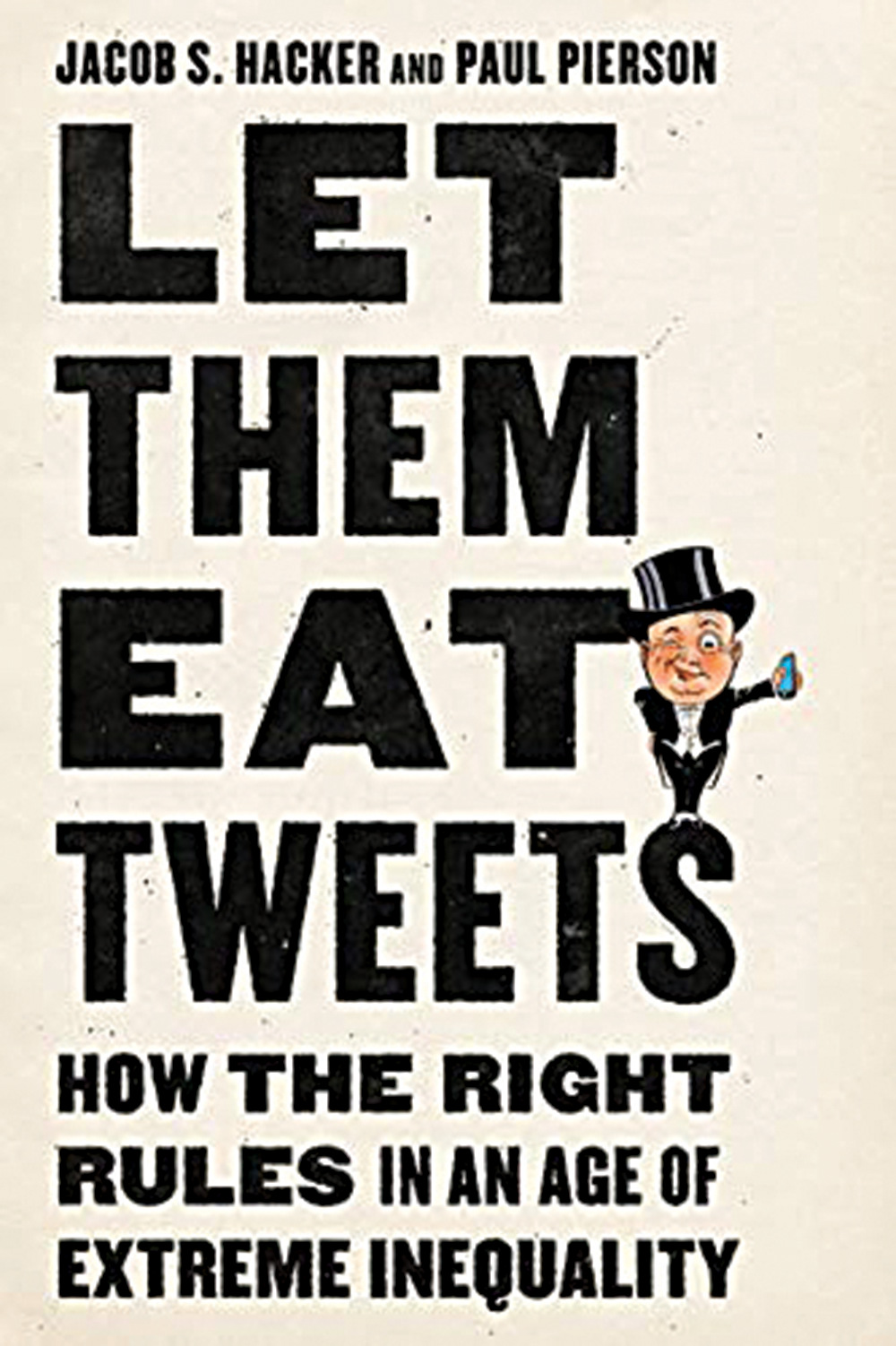Let Them Eat Tweets, by Jacob S. Hacker and Paul Pierson (Liveright/W.W. Norton, 217 pages)
Jacob Hacker and Paul Pierson are not amused, no matter what their book title says.
In fact, the political scientists, who live on opposite coasts, are convinced that America is becoming a plutocracy, governed not by its people but by its rich people. And they believe that Republicans are to blame.
Hacker and Pierson are established GOP-bashers; in three previous books, the pair skewered “the war on government,” the Republican revolution and “winner-take-all” politics (played, of course, by Republicans. They don’t come to the podium neutral. But hear them out. They’re not specifically out to tear down the Tweeter-in-Chief, but the system that enabled him, a system they say goes back more than 40 years.
The system results from what they call “the conservative’s dilemma,” which is this: Wealthy people have power that derives from their wealth, and they want policies that preserve it. But in a democracy, the poor and middle-class have votes that can take away that power. The wealthy conservative, then, is forced to court a constituency whose interests and needs are vastly different from her own to stay in power, and sometimes decides democracy isn’t all it’s cracked up to be.
Their fear was wonderfully expressed in the mid-19th century by a British conservative, Lord Robert Cecil, who thought that under democracy “the whole country shall be governed by an ignorant multitude, the creature of a vast and powerful organization, of which a few half-taught and cunning agitators are the head … in short, that the rich shall pay all the taxes, and the poor shall make all the laws.”
Some factions in America today, particularly in the streets of Portland, would say, “You got a problem with that?” with no sense of irony.
But British conservatives did, over time, succeed; Hacker and Pierson note that Winston Churchill and Margaret Thatcher governed for nearly six decades, combined. And American conservatives have assumed and retained power in part by using a time-honored strategy: “addressing the material needs of the newly enfranchised.” (Did someone say stimulus checks?)
That alone, however, will not win elections, especially when the opponents offer bigger checks.
Which is why Hacker and Pierson believe that conservatives resort to stoking “cleavages,” or sectional loyalties, which “generate intensity sufficient to motivate potential voters and convince them to put their economic concerns to the side.” In other words, create divisions between people in terms of race, religion or ethnicity. As a policy, that’s plenty flammable, but it becomes downright explosive when combined with the sort of income and wealth inequality that America is seeing now, Hacker and Pierson say.
To make their case, Hacker, at Yale, and Pierson, at the University of California, Berkeley, scroll through a history of bad actors who, over the past 50 or so years, helped to create the political climate we live in now. They range from Richard Nixon to Lee Atwater, from New Gingrich (who they call “something of a founding father of our current political dysfunction,” to George W. Bush and his father. They, of course, save plenty of pages for Trump. But they argue that the plutocracy ball was already rolling back when he was on his first wife, and that most people clinging to it were Republican).
“The very rich invest most heavily in the Republican Party; its politicians, its party organizations, its allied groups, and its causes,” Hacker and Pierson write. Forbes says that of the 100 richest Americans, nearly two-thirds contribute mainly or exclusively to Republican or conservative causes, and they outspend Democrats in the top 100 by a ratio of three to one.
How, then, can they stay in power, since they require the votes of working-class Americans? According to the authors, conservative base-building relies on two “Rs” — resentment and racialization, which studies have shown isn’t difficult even among reasonable people. They cite a 2012 Harvard study in which researchers sent two “good-looking, cheery, and well-dressed” Hispanic-looking people to ride the commuter rail from a suburb of Boston into the city, chatting in Spanish the whole time. The researchers interviewed commuters before and after the experiment and found that after being exposed to the Spanish-speaking men, the commuters were more likely to say immigration should be reduced.
In other words, just two friendly people speaking Spanish created a backlash against immigration within a few days. “When outsiders breach the boundaries of established social groups, those within them often react with resentment, even revulsion,” Hacker and Pierson write.
Imagine, then, a political operative armed with that knowledge and determined to win at all costs, and it’s not hard to see why “dog whistles” are so much of the political conversation these days.
Regardless of where you stand on the political spectrum, Let Them Eat Tweets is an interesting synopsis of one side’s version of how we got to 2016, and where we may be headed in four months. The arguments weaken when Hacker and Pierson propose solutions, most of which involve not re-electing Trump; in fact, they believe the country, and our democracy, needs a “stinging” repudiation of Trump in November. From there, they offer benign and predictable hopes: that the country reform the economy so it’s not so accommodating for the wealthy; a development of a “more robust and inclusive democracy”; strengthening the middle class; and so forth.
To their credit, they insist they’re not out to stamp out conservatives or Republicans. “The hope is not that the GOP gets relegated to permanent minority status. Our institutions create very strong incentives to have just two major parties, and it is neither realistic nor desirable to expect only one of them to rule.” They also give examples of Republican governors that they seem to like, or at least not actively dislike: among them, Chris Sununu, Charlie Baker of Massachusetts and Phil Scott of Vermont.
And the answer to your most burning question: Hacker tweets, Pierson doesn’t.
B
BOOK NOTES
Not being a follower of what used to be known as beauty pageants, now “scholarship pageants,” I just now learned that this year’s Miss America performed a science experiment as her talent.
The potential for chemical explosions onstage may not easily replace the swimsuit competition, insofar as ratings go, but that is certainly interesting. Is the evolution of the beauty pageant interesting enough for not just one book on the subject, but two? Publishers think so. There are two books out this month on pageant culture, strange for a year in which there won’t even be a Miss America pageant.
The first, and likely the best, is Hilary Levey Friedman’s Here She Is, The Complicated Reign of the Beauty Pageant in America (Beacon Press, 275 pages). Props to Friedman for bravely using the term ‘beauty pageant,’ which is no longer allowed in conversation. She is a sociologist with a Ph.D. who lives in Providence, Rhode Island, and is uniquely qualified to lead the discussion, being a state president of the National Organization for Women, daughter of Miss America 1970 and an occasional pageant judge. I am psyched to read this when it comes out this week.
Also out this month is Looking for Miss America: A Pageant’s 100-Year-Old Quest to Define Womanhood by Margot Mifflin (Counterpoint, 320 pages). The title gets to the heart of why there’s suddenly so much talk about pageants; the Miss America contest turns 100 years old next year, and I guess publishers want to get a jump on the predictable jokes about how well she has aged.
(I still don’t understand why we had two asteroid movies at the same time in the summer of 1998, but that’s a topic for Amy Diaz.)
Mifflin is a New York professor who has previously written about the history of women and tattoos (2013’s Bodies of Subversion, powerHouse Books, 160 pages). Her take on pageants looks more like a scholarly book; Friedman’s looks more fun.
Neither is to be confused with The American Pageant, the history book that has been a staple of high-school history classes since 1956. (I still have mine; do you?) — Jennifer Graham






